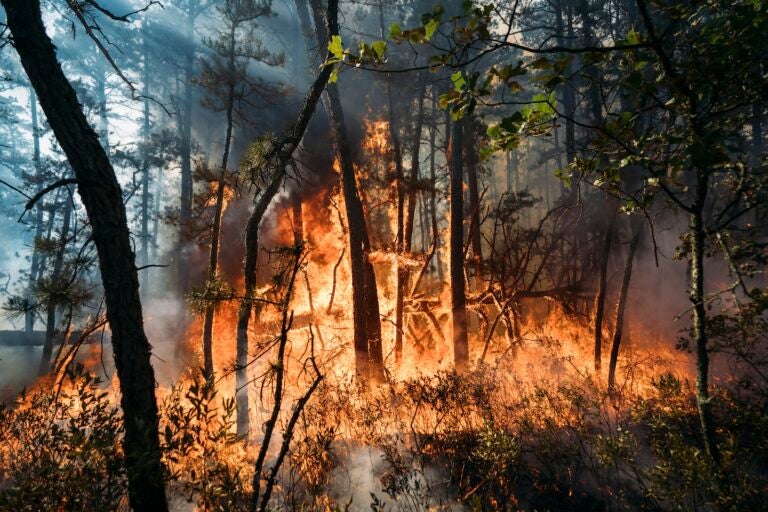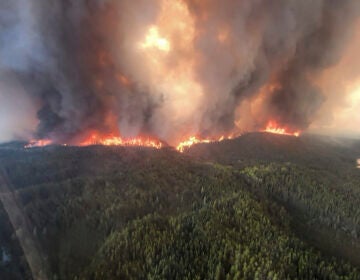A massive N.J. wildfire is nearly contained. Here’s what to know about wildfire smoke
Scientists say forecasts don’t indicate a repeat of last summer’s wildfire smoke emergency in the Philly area.

This Friday, July 5, 2024 image provided by the New Jersey Department of Environmental Protection shows a forest fire in Tabernacle, N.J. (New Jersey Department of Environmental Protection via AP)
From Philly and the Pa. suburbs to South Jersey and Delaware, what would you like WHYY News to cover? Let us know!
Firefighters are gaining control over New Jersey’s largest wildfire so far this year, which burned 4,300 acres in the Pinelands. Investigators believe the fire was sparked by Fourth of July fireworks set off inside the Wharton State Forest. Firefighters say the blaze is 90% contained and are waiting for rain to quench the last remnants.
Wildfires not only release planet-warming greenhouse gasses to the atmosphere, but they can cause poor air quality that makes the air dangerous to breathe.
Last summer, wildfires burning in Canada sent historic amounts of smoke to the Philadelphia region, turning the sky orange in the middle of the day, limiting visibility and making the city’s air hazardous to breathe. The Canadian wildfires disrupted the city’s trash collection, prompted the opening of an emergency shelter and canceled Philly’s Disability Pride parade.
“These levels of … pollution can have health effects on any of us,” then-Philadelphia Health Commissioner Dr. Cheryl Bettigole said at the time.
But the forecasts do not indicate conditions that would send smoke as intense as last year’s to the Philly region, said Patrick Gonzalez, climate change scientist and forest ecologist at the University of California, Berkeley.
Over the next three months, wildfire weather forecasts show above-normal fire weather severity over much of Canada and above-normal wildland fire potential in parts of the western U.S. The mid-Atlantic is forecast to experience above-normal wildland fire potential during July, but normal potential in August and September.
Still, wildfire season in eastern North America is forecast to be less severe this summer compared to last year, said Gonzalez.
“It was an anomalous year,” said Joseph Wilkins, a professor of atmospheric science at Howard University. “It was just perfect conditions of weather bringing a bunch of megafire smoke down at the same time. So I’m hopeful that that doesn’t happen again. … It is possible — it’s just not probable.”
Here’s what you need to know about wildfires and air quality.
WHYY is your source for fact-based, in-depth journalism and information. As a nonprofit organization, we rely on financial support from readers like you. Please give today.






